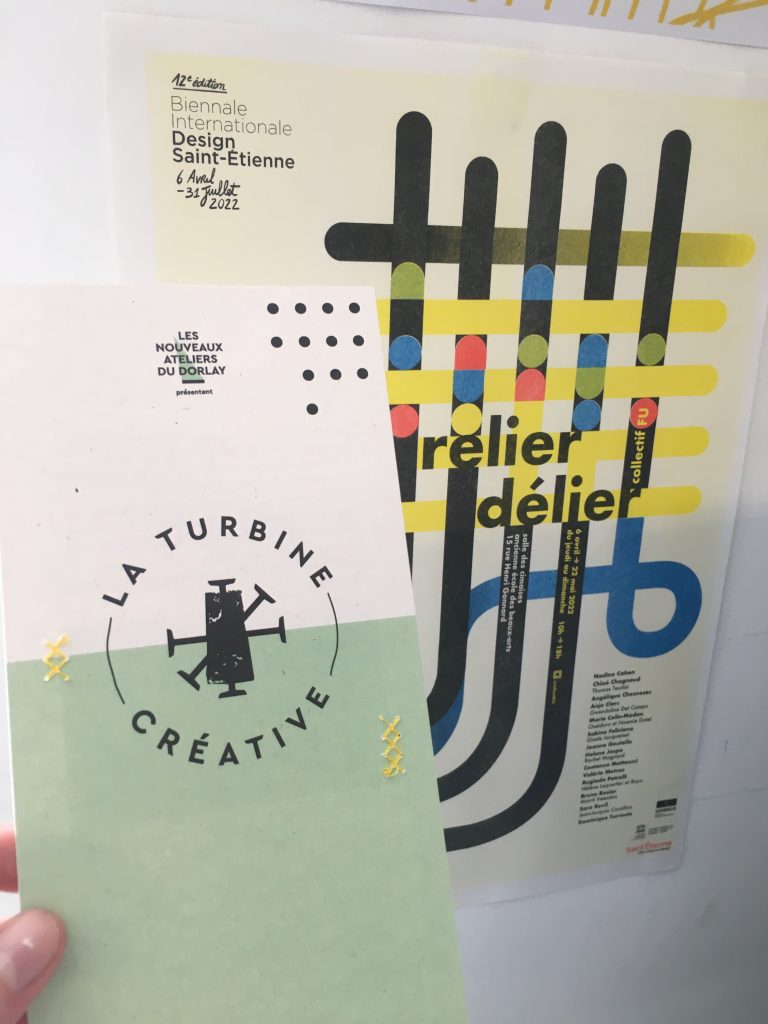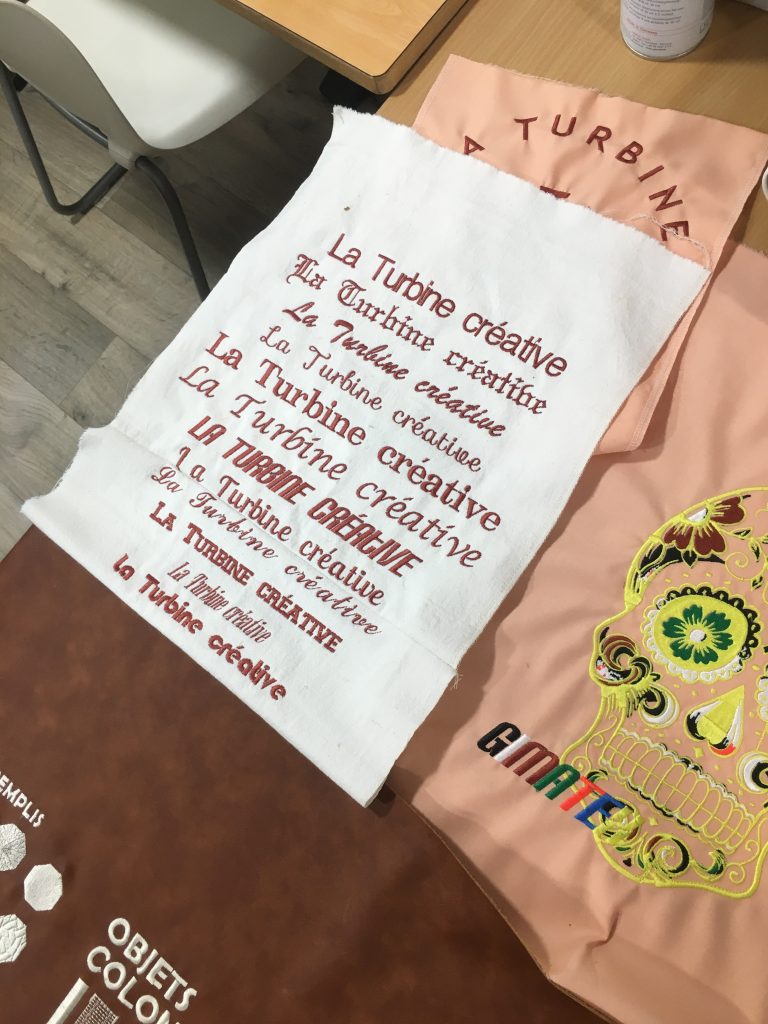As a part of our work on the #SMOTIES project working in small and remote places we have the opportunity to visit all the partners that we are collaborating with. This gives us a chance to have valuable in person meetings to help develop collaborative methodology and to visit and learn more about each partner’s selected rural place.
A couple of weeks ago the Clear Village team visited the town of Saint Etienne in the Rhone-Alpes region, and proudly France’s only “UNESCO Creative City of Design” for a visit hosted by our partners at Cite du Design. Our visit combined both representing the SMOTIES project at the Bifurcations design Biennale by Cite du Design as well as a day visiting rural spaces that have been chosen for the SMOTIES project.
Upon arrival we were all treated with a tour around some of the exciting exhibitions on offer at the biennale, from ‘At home’ an exploration of design and our behaviors within the home, to ‘Auto fiction’ imagining new futures for the automotive industry.
“With 7 exhibitions and more than 150 events, the Biennale is an invitation to join a collective reflection on if and how design can support us when faced with bifurcations. A critical, forward-looking tool, an inventive method, a cultural phenomenon, design is the subject of the debate in Saint- Étienne.”
Olivier Peyricot, Scientific Director of the Biennale Internationale Design Saint-Étienne, Director of the Research Platform Cité du design-ESADSE
The next day we hopped on the coach out to the Dorlay Valley, in the Pilat Regional Nature Park. One of the largest rural spaces in the SMOTIES project, we focused on three key villages in the region.
The first, Sainte-Croix-en Jarez, was famous for a Carthusian monastery, still now a focal point of the village. We were led by designer Isabelle Daëron on a walking route that the monks used to take, along the way we were greeted by installations hidden in the landscape and an audio narrative combining these art pieces with the history of the site.
Photos courtesy of Isabelle Daëron and Pierre Grasset
After sampling some local chartreuse we were whisked away to our next stop, in the village of La Terrasse sur Dorlay, The commune covers an area of 8.7 km² and has 776 inhabitants. During the second half of the 19th century, the braid and lace industry was the main industrial activity in La Terrasse-sur-Dorlay.We visited an exhibition in a textile fablab from the Turbine Créative with students of the ESADSE who had the opportunity to live in the village and make work between the rural fablab and the historic museum of braids and laces which was to be our very next stop…
“The House of Braids and Laces, alongside the banks of the Dorlay River and behind the walls of a former textile factory, witnesses a rich local industrial past. This place, thanks to its natural environment, the essential role of water and the hydraulic installations built in order to harness its power, and also its architecture, stands as one of the last representatives of the numerous factories that existed in the valley.
The workshop, filled with wooden braiding machines, becomes for the time of the guided visit the living conservatory of a unique – but still unknown – expertise. Our association’s goal is to revive this distant echo from our collective memory.
“ – Maison des Tresses et Lacets
We were taken on a tour from the river being sectioned off into 3 separate lakes to feed the cast iron water wheel which we then watched power some of these historic machines. It was interesting visiting this museum immediately after seeing the students of the ESCADES work, it made me see the place in a new light, rural craft based museums can often get forgotten, but the students were clearly inspired by this place giving it new value and purpose.
IMAGES FROM MUSEUM
After this we were invited to a round table with mayors from 4 of the regions in the Dorlay Valley. As all the towns are a part of the Pilat National Park, and some used to be a part of a larger commune, the mayors often worked together sharing services and coming together to promote development in the region. This round table was one of the most interesting part of the trip, learning about the struggles and solutions each of them faced as well as their relationship with design to develop the region. One question was how life in the rural spaces has changed post covid, each mentioned how they are ‘full’ with very little new spaces or buildble land left in the region to meet the demand. Widely regarded as one of the most beautiful places in france to live as well as being just 40 minutes drive away from both Lyon and Saint Etienne, even before the pandemic they had continued interest in people wanting to live in the region. Another interesting point of development was reviving the historic textile industry in the region, such as the connection between students in Turbine Creative and the Museum of Braids and Laces. They spoke of wanting to continue to develop this and rekindle links with the luxury fashion industry and these historic crafts.
The next day was spent at the Biennale back in Saint Etienne with a full SMOTIES Human Cities conference day. After introductory talks from representatives of Cite du Design and Huan Cities, we were treated to visiting talks from both John Thackara and Maxence Bohn from Collectif ETC. Both gave interesting perspectives on designing in rural spaces, how the field of design and architecture can benefit from connecting with these spaces outside of city centres. One project John discussed was the Farm_2_Plate initiative with Alibaba’s livestreaming company Taobao. Farmers were taught how to utilise livestreaming and ecommerce to connect to customers and develop their businesses, the idea being to digitally connect individuals with the farms that supplies their food.
“Our rural livestream program will allow farmers to directly engage consumers face-to-face, allowing them to sell their quality produce at better profit margins,” Sun said.
Last year, Taobao Live hosted more than 150,000 agriculture-related livestreams, which drew over 400 million viewers. Many agriculture livestreamers tasted first success on the platform last year, including Chen Jiubei, who helped farmers in her hometown in Hunan province sell 2 million kilograms of unsalable oranges in 13 days last winter.
“I started livestreaming in May last year for a very simple reason, which is to support my family,” said Chen. Today, her livestreams help farmers in her hometown make what was previously their annual income in a month.
The Collectif Etc is a non-profit organisation based in Marseille (Fr). It has focused its energy on the question of the use of public spaces in the urban environment since it was created in 2011. It has developed its skills and tools to support a new approach of architecture. Using different resources and skills, Collectif Etc is working across architecture, design, urban planning, political studies and art’s fields.
Working in rural context in a non hierarchical way is key to their practice, sacrificing financial stability in order to do so. One project in particular was the ‘Detour de France’ where members of the collective travelled around rural france for a year, connecting people and making interventions in each new space.
The two main objectives set by the members of the Etc Collective were as follows:
1. Carry out an inventory and analysis of all existing creative participation practices in France.
2. Intervene in collaboration with local actors to carry out projects during our stops in the cities. These projects could range from a few days to a few weeks.
The evening activities of the conference consisted of Pecha Kucha style presentations from representatives of each partner organisation on their remote places, their activities and struggles. I chose to present not just background into our remote place in Wales, but also the unique struggles of working as a London based organisation, as a part of an EU project work in a welsh context. I wanted to spend some slides discussing the complex history between Wales and England, the importance of the Welsh language as a symbol of pride, and some of the struggles faced by English people buying properties to use for Airbnb, creating bubbling tensions.
We at Clear Village look forward to the next SMOTIES transnational meeting where we hope to present ideas for impact measurement for work package 3.

